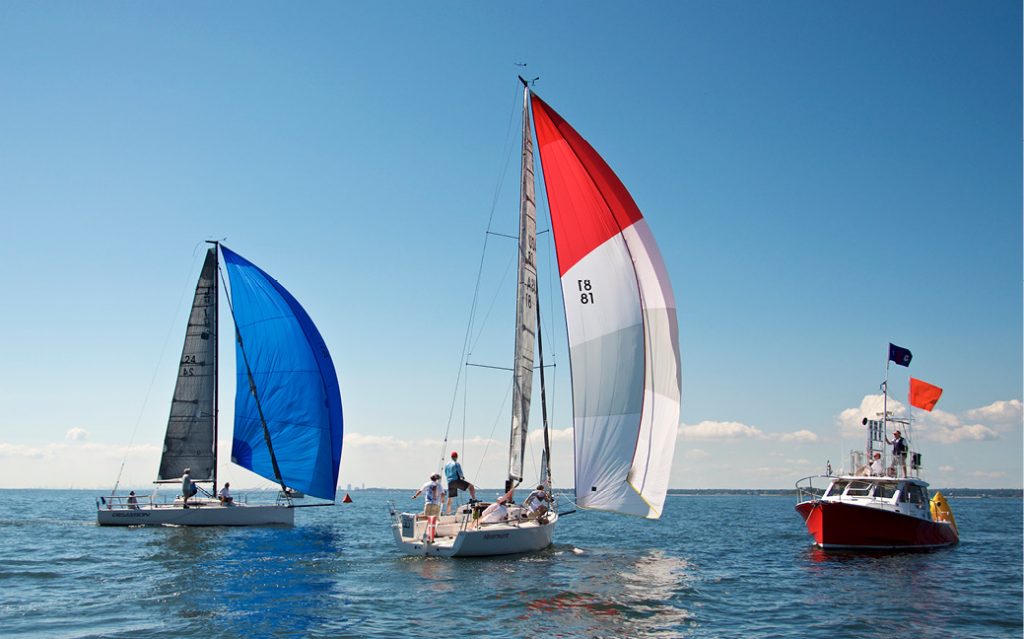By David Dellenbaugh
Your finishing strategy is a plan for how you will get to the finish line as quickly as possible in the absence of other boats. As you near the end of the race, you must make two major decisions: First, at which end of the line will you finish? Second, how will you maneuver your boat to cross the line?
It is usually best to finish right at either end of the line. That’s because one end is almost always favored, and the farther you finish from this end the longer it will take you to cross the line. Finishing at an end also makes it easier to judge how and when to shoot the line.
It’s very important to finish right at the favored end when:?a) you are racing on handicap and every second counts; or b) you are racing one-design and your finish will be close with other boats.
Sailing to one end is not such a priority when: a) you are racing one-design and there are no boats nearby; or b) the finish line is set perfectly square; or c) the finish line is very short; or d) you are heading for the favored end but the wind shifts, so you tack.
Once you know where you are going to finish, you have to get there quickly. Crossing the finish line is unlike any other racing maneuver because after you finish it doesn’t matter how fast you are going. Therefore, as you approach the line you can “shoot” it (by heading straight upwind or downwind) to maximize your short-term VMG (velocity-made-good toward or away from the wind). This would usually mean a big loss in the long run, but it’s not a worry because you will finish before that happens.

There are two important rules of thumb for winning a tight finish, whether it’s upwind or downwind. First, finish very close to the favored end of the line. Second, ‘shoot’ the line so you cross it straight upwind or downwind. © Rick Bannerot/OntheFlyPhoto.net
The mechanics of shooting
In order to shoot the line perfectly, you should approach the favored end from about a boatlength to leeward of the layline to that end (or from above the layline if you are finishing downwind). It’s important to start below the layline so when you shoot the line you end up right at the favored end. If it’s close at an upwind finish, shoot on starboard tack so you have right of way (on a run this is less important because the buoy room rule applies).
As you get closer to the line, the key is knowing when (i.e. how far away from the line) to begin your turn. If you wait too long, you will lose the advantage you’d gain by shooting. But if you start too early you may lose all your momentum before you reach the line! Shooting too late is a more common mistake, but it’s obviously much less risky.
The point at which you should begin shooting the line depends on a number of factors, including:
Type of boat – A heavy boat holds its momentum longer than a light boat and will therefore coast to the finish from farther away.
Current – If the water is moving toward (or away from) the wind, this can make a gigantic difference in how far you are able to shoot.
Wind velocity – In stronger winds you will be going faster and therefore you can start shooting the line from farther away.
Waves – Upwind you can coast better in flat water, but downwind you may shoot farther in waves.
Normally when you shoot the finish line you should turn the boat until you are head to wind (or dead downwind at a running finish). However, if you are not right at one end of the line and if the line is not square, you should stop turning when your course is perpendicular to the finish line.
There are a few other things you can do to shoot faster. At an upwind finish, be sure to release your sheets completely so the sails don’t backwind. You might even consider dropping your headsail, especially if it’s an overlapping genoa. Finally, use sail trim and weight movement to help turn the boat as much as possible so you avoid slowing the boat by over-turning the rudder. ■
This article originally appeared in David Dellenbaugh’s Speed & Smarts, The newsletter of how-to tips for racing sailors. If you want to sail faster and smarter, log onto SpeedandSmarts.com.
A resident of Easton, CT, Dellenbaugh was tactician and starting helmsman for America3’s successful defense of the America’s Cup in 1992. He’s a Lightning World Champion, two-time Congressional Cup winner, seven-time Thistle National Champion, two-time winner of the Canada’s Cup, three-time Prince of Wales U.S. Match Racing Champion, and a winner of the U.S. Team Racing Championships for the Hinman Trophy.
